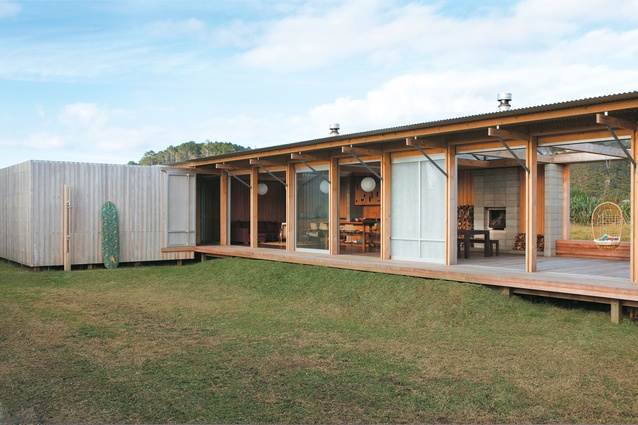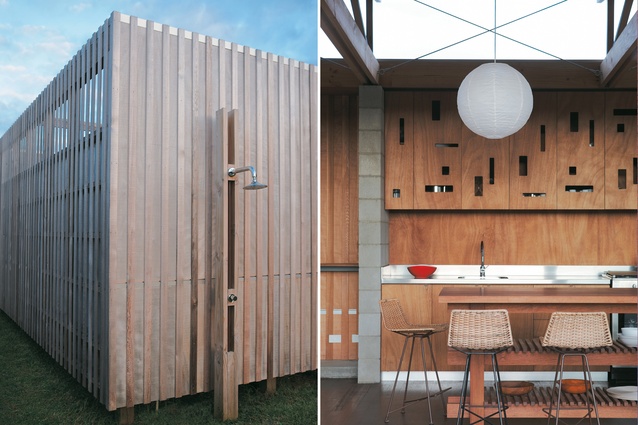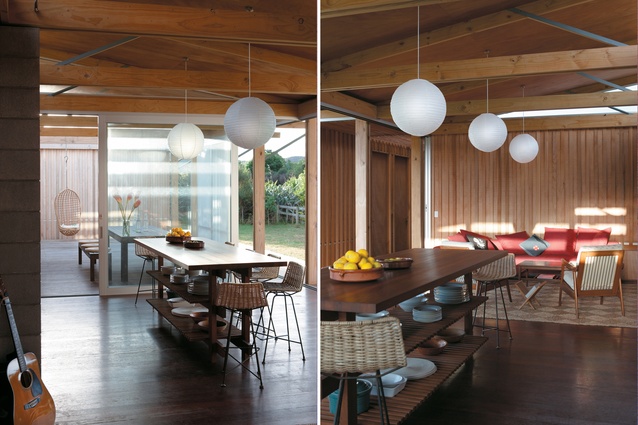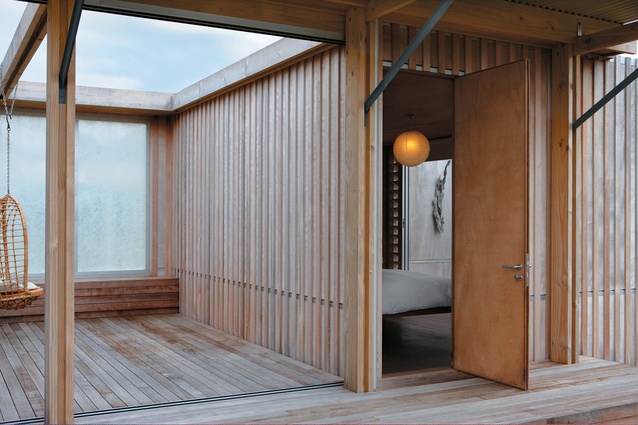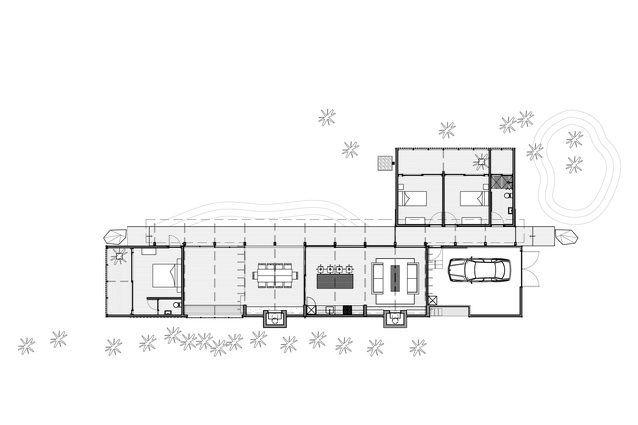Houses Revisited: No barrier to class
At the far reaches of the Hauraki Gulf, revisit a home by Herbst Architects – one in their remarkable series of modern baches.
Great Barrier island in the off-season, and the waves along Medlands Beach break steadily along the shoreline with the sound of tearing paper. The southwest wind is pervasive, rifling through clothing and raising miniature sand storms. A hundred kilometres from downtown Auckland, the island is the last stop on the outer edge of the Hauraki Gulf. Beyond lies the vast blue of the Pacific.
The airport at Claris is just a 30-minute flight from Auckland, but Great Barrier is still off the electricity grid. There are no banks and cell phone coverage is patchy. The island is balanced between isolation and comparative accessibility; it’s classic New Zealand, constructed from memory by the latté generation – Waiheke without the commuters, the Coromandel without the beachfront developments. There’s space, quiet and seclusion – and the local store sells hummus.
Similarly, the Compson bach – one of five at Medlands Beach designed by Auckland’s Herbst Architects – has all the benefits of proximity to nature, with none of the discomforts. However, it’s no luxury mega-bach plonked on its own promontory overlooking the sea, but rather a building of modest proportions on an ordinary, flat plot of land bordered by neighbours.
The building’s frontage takes this sense of modesty almost to the extreme. The walls give nothing away: no windows are visible from the road, and the front door is a simple, sliding panel of flat, translucent random mat fibreglass sheeting. The building is wrapped in a skin of silvery-grey western red cedar; on a bad day, until one is close enough to see the finer details, it could even resemble a shed.
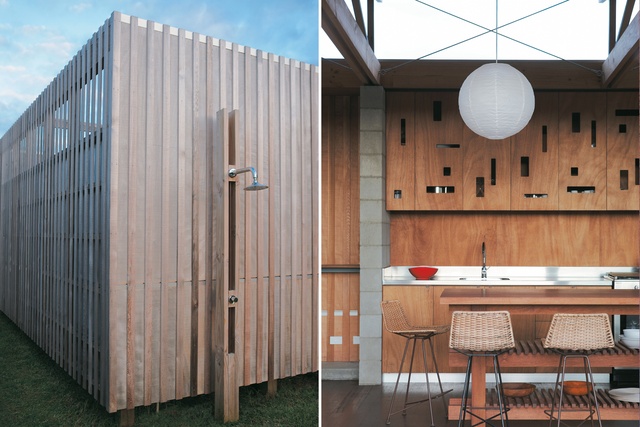
“Doug and Christine Compson had seen our work at the Barrier and basically said, ‘We want one of those’,” says Lance Herbst, who with his wife and practice partner Nicola also owns a holiday home (designed by Herbst Architects) at Medlands Beach. (With a population of around 850, the Barrier tends to be like that.)
“We were trying to achieve a place that was low-key but nicely detailed, so we worked with the clients on the same things we always try to get with our Barrier baches – a blurring of inside and outside, and the crossing of outside space to move between different areas of a house.”
The building can roughly be described as two rectangles of different lengths lying side by side, divided by a central spine – a covered walkway, which in a traditional house would be called a hallway. In this house, once the front and back door are drawn back, the walkway is revealed to be a broad, slatted deck running the length of the building, a die-straight line cutting through the structure from roadside to back steps. Though ostensibly sheltered from the elements, the edges of the fibreglass door panels are inset slightly, allowing air and light to penetrate.
One side of the building houses the bathroom and two bedrooms. The other, longer side contains the open-plan living area with kitchen and lounge, sheltered barbecue and dining area, and at the farthest reach of the building, a secluded master bedroom with its own entrance. The end closest to the road holds the garage and storage area.
The bach is seemingly simple, but it’s more of a puzzle box than is apparent at first glance. It is characterised by series of moveable wall-sized glass panels and fibreglass screens that define light, shade and shelter, and are designed to make the most of the limitations of the surrounding plot. “One of the builders referred to it as the ‘inside-out house’,” says Herbst. “I thought that was quite fitting.”
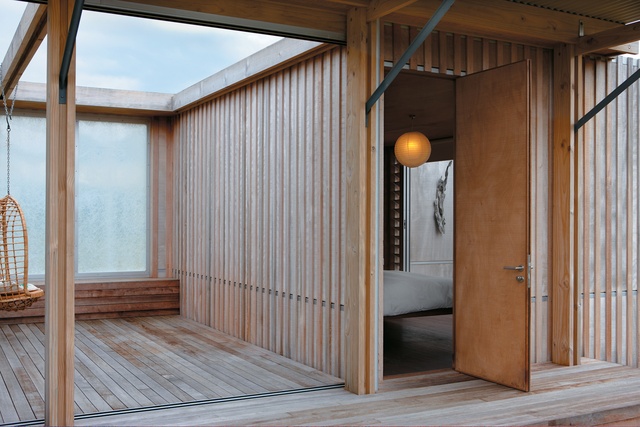
The whole house turns its back on the island’s notorious southwest wind, using the pitched roof, sliding screens and covered outdoor space to create both wind shadows and sun traps. “We were responding to the site,” Herbst says. “There’s no view and no building next door yet, so we kept it low, with everything at ground level.”
Each bedroom has a private sheltered deck with a dropped translucent screen that acts as kind of lightwell, allowing total privacy while admitting light through the permeable skin of the house. In a holiday house, Herbst says, “you don’t want to be opening and closing curtains all the time. We wanted it to be the kind of house you can walk around in after your swim and have a high level of privacy.” The height of the screens was also lowered slightly to give a clear view of the silhouette of the nearby mountain, the closest the site offers to a traditional outlook.
The wood panelling used throughout the project adds a mellow quality to the light, with the exposed grain lending its own low-key detail. The materials were chosen for their texture, weathering characteristics, durability and inherent natural qualities. (While fibreglass may not actually be natural, says Herbst, the type used here, with its visible fibres, had a natural quality nonetheless).
The layout of the bach, which is rented as a holiday home when not being used by the clients and is often occupied by two couples, also gives a range of spaces to “escape to” within its walls, Herbst says. The bedrooms are close to the main communal living area, but separated by the covered walkway or, in the case of the master bedroom, by the large outdoor barbecue area. It’s hard not to imagine somnolent afternoons and quiet hours devouring holiday novels.
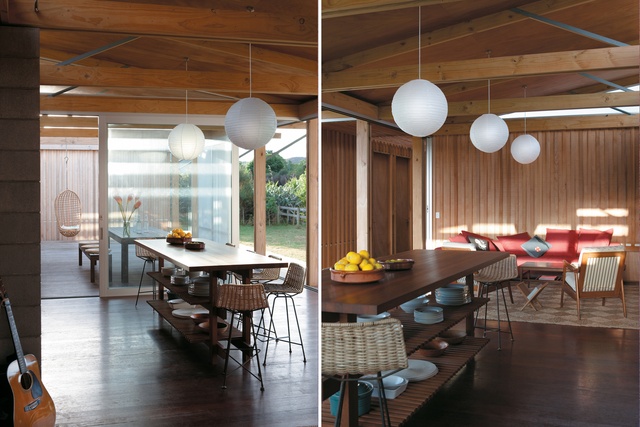
By contrast, the living area is designed for entertaining. On hot sunny days the glass walls slide back so the space is totally open; the semi-opaque screen can also be opened to catch the last rays of the setting sun. At night and in poor weather, the whole assembly closes up, the laminated sliding doors sealing out drafts and sealing in the day’s warmth. On a gusty, grey spring evening, it’s surprisingly cosy.
Given the lack of a central power system on the island, Lance Herbst says he designs Barrier baches on the premise that less is more. “I pare down the requirements. There’s limited lighting, low-energy cooking and a lower demand on the solar energy system it has in place. Basically, the system can deal with lighting, a CD player and running the septic system.” A gas bottle powers the fridge and stove, a buried tank collects rainwater, and if extra heating is needed, there’s a very effective fireplace.
In marrying that essential make-do bach aesthetic with a refined, carefully executed plan that takes in all the little details, this building reflects the nature of the island itself.
This article first appeared in Houses magazine


